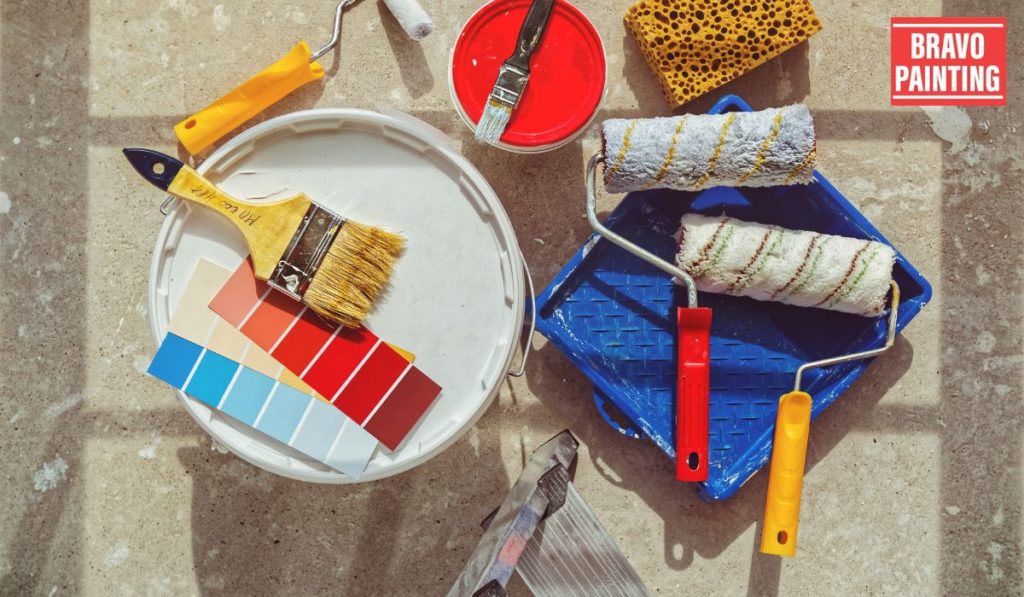Painting brick walls can transform the appearance of a space, giving it a fresh and updated look. However, proper preparation is crucial to ensure a smooth, long-lasting paint job. This article will guide you through preparing brick walls for painting, helping you achieve professional-looking results.
Assessing the Condition of the Brick Wall
Before you begin the preparation process, it’s crucial to assess the condition of the brick wall. This will help you identify any damages that need to be repaired and determine the necessary steps for achieving a smooth and even paint finish.
Inspecting for Damages
Start by thoroughly inspecting the brick wall for any signs of harm, such as cracks, holes, or crumbling mortar. These issues should be addressed before painting to ensure a durable and aesthetically pleasing result. Also, take note of any areas that require repair.
Cleaning the Surface
Cleaning the brick wall is an essential step in the preparation process. Use a stiff brush or an accent washer to remove dirt, grime, and loose debris from the surface. Please pay close attention to mold or mildew growth areas and use a mild detergent or bleach solution to clean them thoroughly.
Repairing and Preparing the Brick Wall

After assessing the condition of the brick wall and cleaning the surface, it’s time to focus on repairing any damages and preparing the wall for painting.
Filling Cracks and Holes
Using a suitable brick repair compound or mortar mix, carefully fill in any cracks or holes in the wall. Use a trowel or flexible knife to apply the mixture, ensuring it is level with the surrounding brickwork. Allow the filler to dried according to the maker’s instructions, and then sand it smooth.
Removing Loose or Damaged Mortar
Inspect the mortar joints between the bricks for any loose or damaged areas. Then, use a chisel & hammer to remove the old mortar carefully, being cautious not to damage the surrounding bricks. Once the damaged mortar has been removed, apply new mortar using a pointing trowel to fill the joints evenly. Finally, smooth the joints with a jointing tool for a neat and uniform appearance.
Sanding the Surface
To create a smooth surface for painting:
- Lightly sand the brick wall.
- Use medium-grit sandpaper and a sanding block to remove rough patches or uneven areas.
- Be careful not to overspend and damage the brick surface.
- After sanding, wipe away any dust with a clean, damp cloth.
Painting the Brick Wall
Once the brick wall has been adequately repaired and prepared, it’s time to apply the paint. Follow these steps for a successful painting process:
- Choose a high-quality exterior masonry paint that is suitable for brick surfaces.
- Start by applying a coat of primer formulated explicitly for masonry surfaces. This will ensure better adhesion & durability of the paint.
- To begin, utilize a paintbrush to carefully cut in along the edges and corners of the wall. Afterward, employ a roller to cover the more significant areas with paint.
- When applying the paint, ensure that you use thin and even coats, allowing ample time for each skin to dry thoroughly before proceeding to the next one.
- Depending on the desired coverage and color, you may need to apply numerous coats of paint. Follow the manufacturer’s instructions for drying times between coats.
- After the final coat, carefully inspect the painted wall for any touch-ups or areas that require additional attention.
FAQs
1. Can I paint a brick wall without preparing it first?
Skipping the preparation process when painting a brick wall is not recommended. Proper preparation ensures better paint adhesion and helps prevent peeling or cracking.
2. What type of paint should I use for painting brick walls?
Using high-quality exterior masonry paint formulated explicitly for brick surfaces is advisable. This type of paint offers better durability and protection against weather elements.
3. How long does it take to prepare a brick wall for painting?
The time required for preparation depends on the condition of the wall and the extent of repairs needed. Therefore, allocating sufficient time for cleaning, repairing, and allowing the surfaces to dry before the painting process is essential.
4. Can I paint over mold or mildew on a brick wall?
No, cleaning and treating mold or mildew growth on a brick wall before painting is essential. Use a mild cleaner or bleach solution to remove the mold, and ensure the surface is dried before applying paint.
5. Should I hire a professional to paint brick walls?
While painting brick walls can be a DIY project that requires careful preparation and attention to detail. If you need more clarification or the necessary experience, hiring a professional painter to ensure a high-quality result may be beneficial.

6. Can I paint a brick wall that has been previously painted?
Yes, you can paint a brick wall that has been previously painted. First, however, it’s essential to consider the existing paint’s condition. If the color is in good condition, you can proceed with cleaning and preparing the surface before applying a new coat of paint. If the existing paint is peeling or in poor condition, it may be stripped off before painting.
7. How long does the paint on a brick wall typically last?
The longevity of color on a brick wall depends on various elements, such as the quality of paint used, weather conditions, and maintenance. On average, a well-prepared and properly painted brick wall can last 10-15 years before requiring repainting.
8. Can I change the color of my brick wall with paint?
Yes, painting your brick wall is a great way to change its color and update the look of your space. However, remember that once the brick is painted, it can be challenging to revert to its original appearance, so choose a color you’ll be happy with for the long term.
9. Do I need to apply a sealer after painting a brick wall?
Using a sealer after painting a brick wall is sometimes recommended. A sealer can help enhance the durability and longevity of the paint, as well as provide added protection against moisture and stains. Check the manufacturer’s instructions for the color you used to determine if a sealer is necessary.
10. How do I maintain a painted brick wall?
To maintain a painted brick wall:
- Regularly examine it for any signs of damage, such as peeling or cracking paint.
- Clean the surface periodically using mild detergent and water.
- Avoid using abrasive cleaners or harsh chemicals that can damage the paint. If you notice any issues, touch up the color to maintain its appearance and protect the brick.


